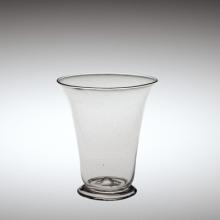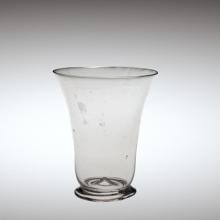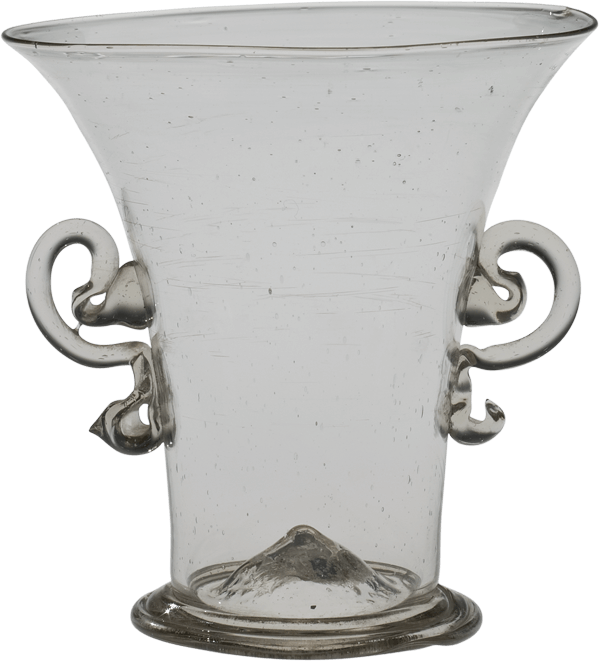Small Cup with Two Handles
Small Cup with Two Handles
This video shows the making of a flared two-handled vessel. The base of the vessel has a kick and a trail around the bottom edge. The symmetrical handles are added as the final step.
Transcript
The glassblowing begins with gathering molten glass on the end of the metal blowpipe. As the glass cools, it’s rolled back and forth on the metal table called the marver. Air is blown into the blowpipe, and a bubble begins to form. For this process, it’s necessary to cool the tip of the gather.
The glass is reheated, a rubber tube attached. The rubber tube will allow air to be blown into the pipe during the tooling. A constriction is begun near the blowpipe; the bubble is inflated and pulled outward suddenly. The constriction is made narrower, and excess glass is trimmed free at the bottom of the bubble.
The outer half of the bubble is softened. With jacks, the two-bladed tools are used to shape the lower part of the bubble. The bottom is flattened. A kick is created by pushing one of the blades of the jacks into the bottom. A small amount of glass freshly gathered from the furnace is trailed onto the edge of the base of the cup. This is reheated to thoroughly melt it into the glass. The vessel is transferred to a punty (or pontil). This is simply a handle. The neck is broken, and the open end reheated.
The opening process begins. The jacks are used to enlarge the diameter, and after reheating, the soffietta (or puffer) is used to inflate the glass. This changes the shape of the shoulder.
A small amount of glass is added for the first of the two handles. The handles are flat. The first attachment is made, the glass cut free of the gathering rod. The end is twisted to hide the shear mark, and the second attachment point made. The process is repeated. Throughout, the cup must be kept well over 1000 degrees Fahrenheit, or cracking will occur.
The final vessel is flashed in the furnace and broken free of its punty, placed in the annealing oven for slow cooling.
The vessel was formed by pulling outward on a soft glass bubble. There’s an alternative method. A sphere is blown. The constriction is formed. The bubble is blown larger, and the neck made narrower. And here, the sphere will be elongated with gravity and centripetal force. The result is very similar. We can’t be sure which process was used in the original object.
On the left handle, a small flaw can be noticed. During the final shaping of the handle, there was inadvertent contact made between two parts. They were then pulled away, leaving this thin, thin thread. It’s interesting to see how that might have been formed. When it’s inverted, the lower part touches inadvertently. The handle is pulled away to give it its final shape, and there’s the small thread.
See all: Objects and Techniques



